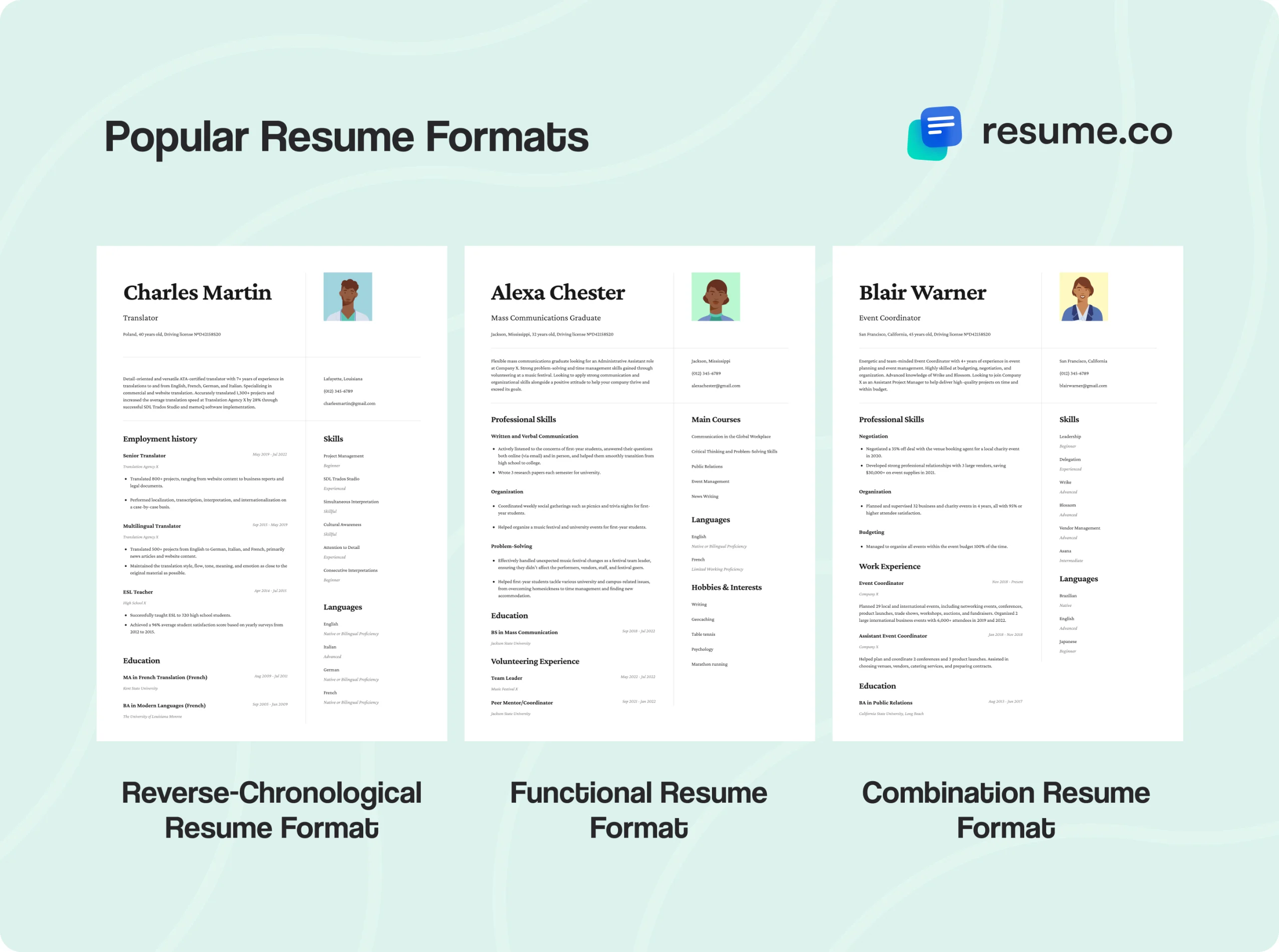If you’re an architect, creativity is definitely your forte, and working on complex projects is your specialty. However, when it comes to writing an architect resume, you may not be sure where to start, especially if you’re doing it for the first time.
Worry not—that’s exactly why we’ve written this exhaustive yet concise guide to help you out.
You’ll learn what information an architect resume needs to have, how to include it in an optimal way, and how to fine-tune the minor details for maximum effect.
So, not to waste any more time, let’s jump right in!
Key Takeaways
One of the best ways to present information on your resume is to use the reverse-chronological format.
Your architect resume must contain your personal information, a resume objective or summary, work history, education details, and skills.
You can make your work history section pop by utilizing bullet lists, numbers, percentages, action verbs, and power words.
Submit a personalized cover letter that matches your resume to greatly increase your chances of success.
What is the Right Format to Use for an Architect Resume?

Choosing an adequate architect resume format is the first step toward crafting a professional document. A proper format helps you optimally convey information to recruiters so that you can give them what they want and spark their interest.
There are three popular resume formats that have stood the test of time and become much more popular than the rest.
A chronological resume format is by far the most common of these three. That should come as no surprise since this format neatly organizes information in reverse-chronological order. It’s not only favored by recruiters, but it’s ATS-friendly as well.
However, if you lack professional experience, you might want to take advantage of the functional resume format. This one emphasizes your skills over experience. As such, it’s perfect for entry-level applicants, though its particular structure may run into issues with the ATS.
On the flip side, if you have decades of professional experience, a combination resume format will help make your refined skills more prominent while backing them up with some great and relevant achievements.
Resume templates
Resume templates that are designed to help you win a jobResume Layout
You know that a visual appearance can make or break a project. For this reason, creating a good resume layout is essential.
To end up with a clean, professional, and legible architect resume, consider the following guidelines:
Resume Layout Guidelines
You should choose a resume-friendly font (e.g., Calibri or Helvetica) and make your text size 10–12 pt. To create a visual hierarchy, you can use the 14–16 pt font size for section headings.
To make separate sections even more prominent, you should have enough space between them while keeping margins at least one inch on all sides.
By using bullet lists instead of blocks of text, you’ll convey the same amount of information more efficiently and in an aesthetically pleasing way.
What Sections Should an Architect Resume Contain?
No matter the position you’re applying for, these sections are a must-have on your architect resume:
Resume Mandatory Details
Contact information
Resume summary or objective
Work history
Education
Skills
If there’s some room left after you’ve added those, you should consider including some of these optional sections in your resume, too:
Resume Optional Details
Courses
Awards
Seminars
Conferences
Projects
Publications
Languages
We’re about to dive into the specifics for each of these sections, but if you want to start creating your architect resume immediately, you can use our resume builder and simplify the process! Our resume-building tool comes with preset sections, layout, font, and color schemes (all of which you can change with a few clicks), and all you have to do is put your information in the blanks!
Architect Resume Template
To give you an idea of how efficient our resume-building tool truly is, here’s an architect resume template made with it:
Architect Resume Template
Name and Surname
Phone number: 000-000-0000 | Email: namesurname@gmail.com | Location: City, State
[Adjective] [your job title] with [years of experience, if applicable] in [your area of expertise, if applicable] looking for a [position] job at [company name]. Eager to apply [relevant skills] gained through [work/volunteer/other experience] to help [company name] [mention what you can do for the company].
Work Experience
Most Recent/Current Job Title Company City, State [Start date] — [End date]
For recent jobs, use 5-6 bullet points to list your top achievements and responsibilities
Use action verbs to make your responsibilities and achievements stand out
Add numbers to quantify your achievements
Previous Job Title Company City, State [Start date] — [End date]
For recent jobs, use 5-6 bullet points to list your top achievements and responsibilities
Use action verbs to make your responsibilities and achievements stand out
Add numbers to quantify your achievements
Oldest Job Title Company City, State [Start date] — [End date]
For older jobs, use 2-3 bullet points to list your top achievements and responsibilities
Use action verbs to make your responsibilities and achievements stand out
Add numbers to quantify your achievements
Education
[Degree] in [Major] [University/college name] [Start date] - [Graduation date]
Skills
Soft Skills
Skill #1
Skill #2
Skill #3
Skill #4
Skill #5
Hard Skills
Skill #1
Skill #2
Skill #3
Skill #4
Skill #5
Additional Sections
Add any relevant additional sections (languages, licenses, publications, hobbies, etc.)
Architect Resume Contact Information

Every architect resume should begin with the candidate’s contact information. You can simply put your name, job title, phone number, and professional email address in your resume header and call it a day.
However, if you want to go the extra mile, you could include links to your LinkedIn profile and to your website or portfolio. These bits add tremendous value to your resume as a whole, even though they are typically optional.
Here’s an example:
Contact Information Example
Betty Strong
Architect
+ 253 449 0902
bettystrong@example.com
linkedin.com/in/bettystrong37
bettysportfolio.com
Your address is another optional piece of information that is often left out these days because of anti-discrimination laws. You should only include it if the job ad requires it, and even then, you should only add your city and state.
Lastly, your contact details need to be simple but sharp. That means no witty job titles, no irrelevant social media pages, and no funny email addresses made during your skateboarding days back in high school.
Architect Resume Objective or Summary

A resume objective or summary are to-the-point paragraphs that serve to present you in the best light possible. The goal is to hook recruiters into reading the rest of the document since they might spend as little as 7 seconds skimming through it.
If you’re new to the field, a captivating architect resume objective will help you highlight your skills and professional goals.
On the other hand, a resume summary is a short recap of the whole resume. It allows experienced candidates to highlight their most impressive workplace accomplishments.
Entry-Level Architect Resume Objective
To write a catchy resume objective as an entry-level architect, leverage your academic accomplishments, and talk about your most prominent abilities and career objectives.
Here’s a good example:
Good Example
“Diligent architecture graduate looking for an opportunity to tackle demanding projects in a collaborative environment. Holder of a Master’s degree with distinction and winner of a nationwide competition in residential building design. Impeccable attention to detail and proven team-leading skills.”
Now here’s a bad example that doesn't give recruiters any factual information to work with:
Bad Example
“Architect with a degree looking to gain real-world experience and to learn and improve my skills.”
Architect Resume Summary

When writing an architect resume summary, add your most prominent achievements, and you’ll have the reader’s attention right off the bat. Be as specific as you can, and use numbers to make the information more concrete.
Here’s a good example:
Good Example
“Licensed architect with 11+ years of experience in the field. Focused on urban design and sustainable planning. Shortlisted for the Pritzker Prize in 2020. Extensive knowledge of industry-standard CAD and BIM software. Dedicated team player looking to join [your company] and make new breakthroughs in the field of green architecture.”
For comparison, here’s a vague and uninspiring resume summary:
Bad Example
“Skilled architect looking for a senior position. Able to work alone or in a team. Proficient in relevant software.”
Architect Resume Work Experience

What better way to show how well you’re going to perform in the new position than by highlighting your past work experience? Let’s find out how to get the most out of this section.
General Tips
The format that you should follow when creating an architect resume work experience section is rather simple and goes like this:
Job title
Company’s name
Dates of employment
List of responsibilities, achievements, and results obtained
Naturally, there are ways to tweak this section to get the most out of it. In this case, it’s the list of responsibilities and achievements that you should focus on.
For starters, you want to emphasize the achievements and results obtained over everyday tasks and responsibilities, as exceptional accomplishments are much better attention-grabbers. A list of 3–5 bullet points per position will have the biggest impact and won’t clutter the section.
To further increase the effectiveness of this part, you should use precise numbers, statistics, and percentages the same way you would in your resume summary. They are immensely helpful at quantifying results and making them more solid.
Finally, choosing compelling action verbs and power words instead of their overused synonyms will make your whole resume more memorable. For example, “conceptualize” feels much more effective than “create.”
No Architecture Experience

Even if you have little to no experience in the field of architecture, you can still follow the general tips outlined above to create a strong work experience section. The difference is that you’ll simply make use of substitute activities like volunteer work, college projects, internships, etc.
Here’s an example of a candidate using their internship to craft a stellar work history section:
No Experience Resume Example
Work Experience
Architecture Intern
Arch Group
Atlanta, GA
December 2021–May 2022
Constructed blueprints for 13 projects while maintaining a 100% compliance rate with all regulations.
Delivered 100% of the projects on time, with 17% of them under budget.
Utilized extensive knowledge in AutoCAD, V-Ray, and Photoshop to speed up design processes by 21%.
Experienced Architect
As an experienced architect, you’ll want to put your best foot forward by highlighting your most impressive accomplishments. If you’re adding several previous jobs to the work experience section, you should do so in reverse-chronological order.
However, aim for quality over quantity. Don’t go overboard, listing every minor task or result obtained, as that could be counter-productive. Instead, focus on those successes that show why you are an expert.
Here’s an example:
Experienced Architect Resume Example
Work Experience
Architect
Block Engineering
San Francisco, CA
July 2018–Current
Led a team of 19 architects to complete large-scale projects on time, with 7 of them being under budget.
Created precise cost estimation reports on 37 projects.
Designed 150+ projects for various corporate clients.
Architect Resume Education Section

The education section is important for making your architect skills more credible—even more so if you’re an entry-level candidate. Here’s what it needs to show:
Education Section Mandatory Details
Your degree
University’s name and location
Years of attendance
And here’s an example:
Education Section Example
Education
Master of Architecture
University of California, San Francisco, CA
2016–2018
Summa Cum Laude
Similarly to the work experience section, you can add notable achievements in the form of a bulleted list. Anything from a GPA of 3.5 and above to extracurricular activities, courses, projects, etc. is worth considering.
You can also add multiple degrees in reverse-chronological order (though you should omit your high school diploma). And there’s even merit to adding an unfinished degree. Here’s an example of that:
Example #2
Education
Master of Architecture
University of California, San Francisco, CA
2021–Current
Bachelor of Architecture
University of California, San Francisco, CA
2017–2021
Even if you dropped out of college, you should still list your degree and how many credits you earned toward it.
Architect Resume Skills

While it sounds simple to create a list with a bunch of skills, add it to your architect resume, and call it a day, there’s more to it if you want to make your resume pop.
For starters, you can gain an edge over other candidates by analyzing the job ad and the position you’re applying for or researching the company. That way, you can deduce which skills they are looking for in particular before adding the ones you possess to your resume.
Also, once you start listing skills on your resume, you should keep soft and hard skills separately since they are quite different.
Hard skills come from your specific knowledge of architecture. They are highly specialized and obtained through formal education, courses, reputable sources, and so on. Hard skills include everything from expertise in specialized software to knowledge of rules and regulations, as well as overall architectural prowess.
On the flip side, soft skills are synonymous with interpersonal skills. They are personal traits you can obtain through life experience, which makes them applicable in many different professions and positions.
On a final note, don’t forget to mention some of your vital skills in other sections of your resume. You could link them to relevant achievements in your summary or work history to make them truly stand out.
Hard Skills
Here are some hard skills that you could add to your architect resume:
AutoCAD
Revit
3DS Max
V-Ray
Lumion
Sketching
Drafting
Modeling
Photography
Technical writing
Soft Skills
When it comes to the soft skills that would look great on your resume, the list goes like this:
Critical thinking
Punctuality
Attention to detail
Organization
Presentation skills
Teamwork
Problem-solving
Architect Resume Optional Sections

Optional sections are perfect when you want to personalize your resume and tailor it to the job posting. These include:
Resume Optional Sections
Courses and certifications, which can help you emphasize your education and add credibility to your skills. You can include them as part of the education section (if they are tightly connected to it) or add them as a standalone part of your resume.
Awards, which show that you were recognized for achieving outstanding results in the field, which makes them an important section of every architect resume.
Seminars, whichhighlight your dedication to the craft and portray you as an active individual in the industry who keeps up with trends, modern technologies, best practices, and more.
Conferences, which, similarly to seminars, highlight your passion for architecture. This section becomes all the more impressive if you have delivered speeches at conferences.
Projects, whichcan help spark recruiters’ interest in your portfolio.
Publications—especially peer-reviewed ones—which portray you as a person of authority and considerable knowledge in the field.
Languages, whichlook impressive on any resume.
Should You Submit a Cover Letter With Your Architect Resume?

Cover letter templates
Create a cover letter by filling in a free template and sharing it for free.The short answer is yes—you should create a cover letter to go along with your architect resume.
Including it in your job application shows that you’re a person of commitment and perseverance who isn’t afraid to go the extra mile to impress prospective employers. And not only that—you can use the letter to expand on some of your skills and projects and get more opportunities to prove yourself to recruiters.
Expert Tips for Creating an Architect Resume
As promised in the introduction, here are expert tips to help you fine-tune your architect resume:
Your resume should be one page long. Many recruiters skim through one-page resumes in mere seconds, meaning they definitely won’t examine two pages or more.
You should submit a soft copy of your resume as a PDF file to make sure it’ll look the same on any computer.
Make links to your LinkedIn and portfolio in your contact education section clickable. It shows your attention to detail and makes it easier for recruiters to visit these pages.
Subtly show your attention to detail as well as your design and organization skills by making sure your resume looks clean, organized, and without any mistakes.
Closing Thoughts
And… that concludes today’s lesson!
Now is the time to grab a pen and paper and start sketching. Then, you open a laptop and create a first draft. And then… Well, you know the rest.
You’ve learned everything needed to craft an outstanding architect resume. Next, you can also brush up on common architect interview questions to ensure you're fully prepared for the next step. Now is your time to shine. Oh, and don’t forget about our resume builder if you want to speed things up!
Your Pritzker prize awaits!
Related Articles
UI/UX Designer Resume Example & Writing Guide


